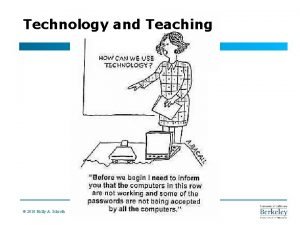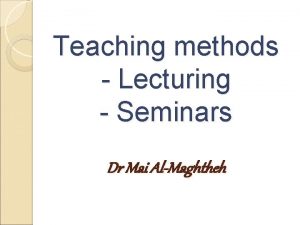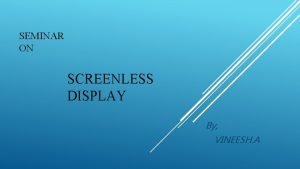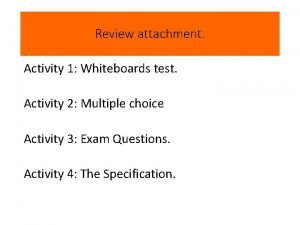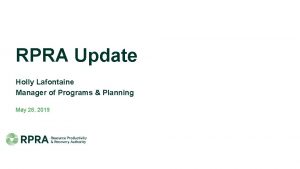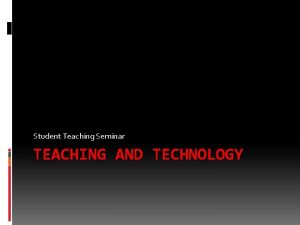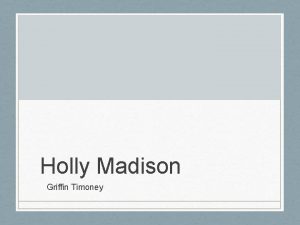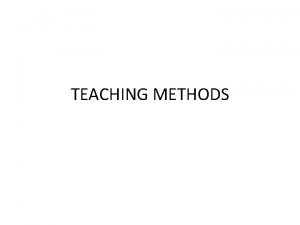Technology and Teaching 2010 Holly A Schroth Seminar



























- Slides: 27

Technology and Teaching © 2010 Holly A. Schroth

Seminar Goals • Ø Demonstrate four different technologies that can be used to engage students • i<clicker • Power Point • Video • Drawing Provide new methods to enhance learning for the millennial generation! © 2010 Holly A. Schroth

i<clicker Why use? • Gets students involved • Tests understanding • Allows for real opinions • Tracks attendance Other • Prepared slides vs. polling • Buy vs. borrow © 2010 Holly A. Schroth

Test Yourself Q 1 A= positive; B = negative; C = extinction; D= punishment Q 1: Employee whines about the sales quotas to colleagues and is ignored Q 2: Employee receives a reward for making a certain number of sales Q 3: Employee falls below sales goals and is required to meet with the sales manager daily or is reprimanded Q 4: Employee meets sales quotas and is no longer required to meet with the sales manager daily or gets reprimanded © 2010 Holly A. Schroth

Equity Theory: Part I O = Underpayment Inequity = Overpayment Inequity I O I = Equity = O I

Equity Theory Part II Person Social A B Comparison Less Than O I Angry O I Satisfied O I Overpayment inequity for Person B More Than O Underpayment inequity for Person B O I Satisfied Equitable payment for Person B I Equal To

The effect of Inequity on Inequity of Resources Motivation © 2010 Holly A. Schroth

Test Yourself Q 3 Jamie discovers that he is paid substantially more for proof reading legal documents than his colleagues, even though their jobs and performances are very similar. According to equity theory he is likely to A = decrease the amount of documents he reads B = decrease the quality of documents he reads C = increase the quantity or quality of documents he reads D = he will leave his job E = there will be no effect © 2010 Holly A. Schroth

Example of Testing for Comprehension –Sequence © 2010 Holly A. Schroth

Problem 1 a Mark is finishing his MBA at a prestigious university. He is very interested in the arts and at one time considered a career as a musician. Is he more likely end up with a job in? A = a management consulting firm? B = the management of the arts? © 2010 Holly A. Schroth

Representative Heuristic Making a judgment based on the resemblance to a typical case while ignoring information about averages or prior probabilities © 2010 Holly A. Schroth

Problem 1 b If I were to toss a coin eight times, which of the following sequence of coin flips is more likely? A = TTTT B = TTTTHHHH C = THTTHHHT © 2010 Holly A. Schroth

Gambler’s Fallacy “Law of Small Numbers” The belief that data collected by a random process will look random; however, the sequence collected is too short for the process to express itself statistically © 2010 Holly A. Schroth

Problem 1 c • A town is served by two hospitals. Approximately 45 babies are born in the larger hospital and 15 babies are born in the smaller hospital each day. • About 50% of all babies are boys but the exact percentage varies from day to day. • For a period of one year, each hospital recorded the days in which more than 60% of the babies were boys. Q: Which hospital do you think recorded more such days? <Click in> A= The larger hospital B=The smaller hospital C= About the same © 2010 Holly A. Schroth

Representative Heuristic: Biasing Factors • Not sensitive to statistical information • Not sensitive to sample size • Misconceptions of chance © 2010 Holly A. Schroth

Vote for the BEST presentation Group 1 Group 2 A = Little Black Dress A = Swish B = Mandex B= Manny hose C= Relaxitrain C = Trax D = Lightning D = Bronze © 2010 Holly A. Schroth

Using Videos Demonstration • Integration/Playback (Real Player, DVD, Videolinks, Embedded) How to use • Purpose (case or application) • Length • Content • Sources • Age of video • Added value • Copyright issues © 2010 Holly A. Schroth

Videocase: Zappos and The Millennials • • Adapt your management style for different generations Coaching is a useful motivational tool (vs. giving directives) Recognize and reward where you can Having a fun workplace can help attract/retain employees Show You Value Your Employees © 2010 Holly A. Schroth

Using Powerpoint • How to use—key points on slides o Avoid clutter o Don’t use as lecture notes o Consider using “take-away” handout for details • Careful material not too redundant with book • Use of a remote/use B-Key Q: Should I post before or after lecture? © 2010 Holly A. Schroth

f o le y p m it a l x a E u Q r o Men are less likely to ask for information or directions o P In decision making, women are more likely to downplay their certainty; men are Gender Differences in Communication 1. 2. 3. 4. 5. 6. 7. 8. 9. Table 14 -4 more likely to downplay their doubts Women apologize even when they have done nothing wrong. Men avoid apologies as signs of weakness or concession Women accept blame as a way of smoothing awkward situations. Men ignore blame and place it elsewhere Women temper criticism with positive buffers. Men give criticism directly. Women insert unnecessary and unwarranted “thank-you’s” in conversations. Men avoid thanks altogether Women ask “What do you think? ” to build consensus. Men perceive that question as a sign of incompetence and lack of confidence Women give directions in indirect ways Men usurp (take) ideas stated by women and claim them as their own. Women allow this process to take place without protest Women use softer voice volume to encourage persuasion and approval. Men use louder voice volume to attract attention and maintain control 14 -20

Process Barriers to Effective Communication f o le ty p i m l a a Ex r Qu o o P 14 -21

Interesting OB Dependent Variables • • Productivity • Transforming inputs to outputs at lowest cost. Includes the concepts of effectiveness (achievement of goals) and efficiency (meeting goals at a low cost). Absenteeism • Failure to report to work – a huge cost to employers. Turnover • Voluntary and involuntary permanent withdrawal from an organization. Deviant Workplace Behavior • Voluntary behavior that violates significant organizational norms and thereby threatens the well-being of the organization and/or any of its members. © 2009 Prentice-Hall Inc. All rights reserved. f o le p m ality a x E u Q r o Po 1 -22

Typical OB Dependent Variables • Productivity • Effectiveness—achievement of goals • Efficiency –meeting goals at a low cost • Absenteeism • Turnover • Deviant Behavior • Theft, sabotage, aggression © 2010 Holly A. Schroth ty i l a d u e Q is r v o e o P e. R d i l S

Charismatic Leader Behaviors • Articulates overarching goal-vision • Communicates high performance expectations • • Exhibits confidence and enthusiasm in the ability of followers to meet expectations Empathizes with the needs of their followers Uses whole body when speaking-paces, sits on desk edge, leans forward, eye contact, relaxed posture & animated face Captivating and engaging voice tone © 2010 Holly A. Schroth

Myers-Briggs T Makes decisions by stepping out of the problem to be objective F Makes decisions by stepping into the problem to be compassionate

Computers in the Classroom • Set a computer policy • Pros and cons © 2010 Holly A. Schroth

Thank You schroth@haas. berkeley. edu © 2010 Holly A. Schroth
 Holly schroth
Holly schroth Normal view
Normal view Seminar teaching method
Seminar teaching method Macro teaching is a scaled down teaching
Macro teaching is a scaled down teaching Screenless display images
Screenless display images Bicmos fabrication process
Bicmos fabrication process Sixth sense technology seminar report
Sixth sense technology seminar report Skybus lahore
Skybus lahore Lifi technology seminar
Lifi technology seminar Sixth sense technology seminar
Sixth sense technology seminar Blue eyes technology seminar
Blue eyes technology seminar Zigbee technology seminar
Zigbee technology seminar Touchless touchscreen
Touchless touchscreen Rfid technology seminar
Rfid technology seminar Genotype environment
Genotype environment Rita and holly are identical twins
Rita and holly are identical twins Rita and holly are identical twins
Rita and holly are identical twins Rita and holly are identical twins
Rita and holly are identical twins Nfpa 2010 aerosol extinguishing technology
Nfpa 2010 aerosol extinguishing technology Knickerbocker number 9 lyrics
Knickerbocker number 9 lyrics Holly grove middle school
Holly grove middle school Gloucester county board of health
Gloucester county board of health Holly sys
Holly sys Dr holly kahya
Dr holly kahya Holly lafontaine
Holly lafontaine Dr eoin fahy
Dr eoin fahy Holly leaf miner
Holly leaf miner Brighouse sixth form
Brighouse sixth form
